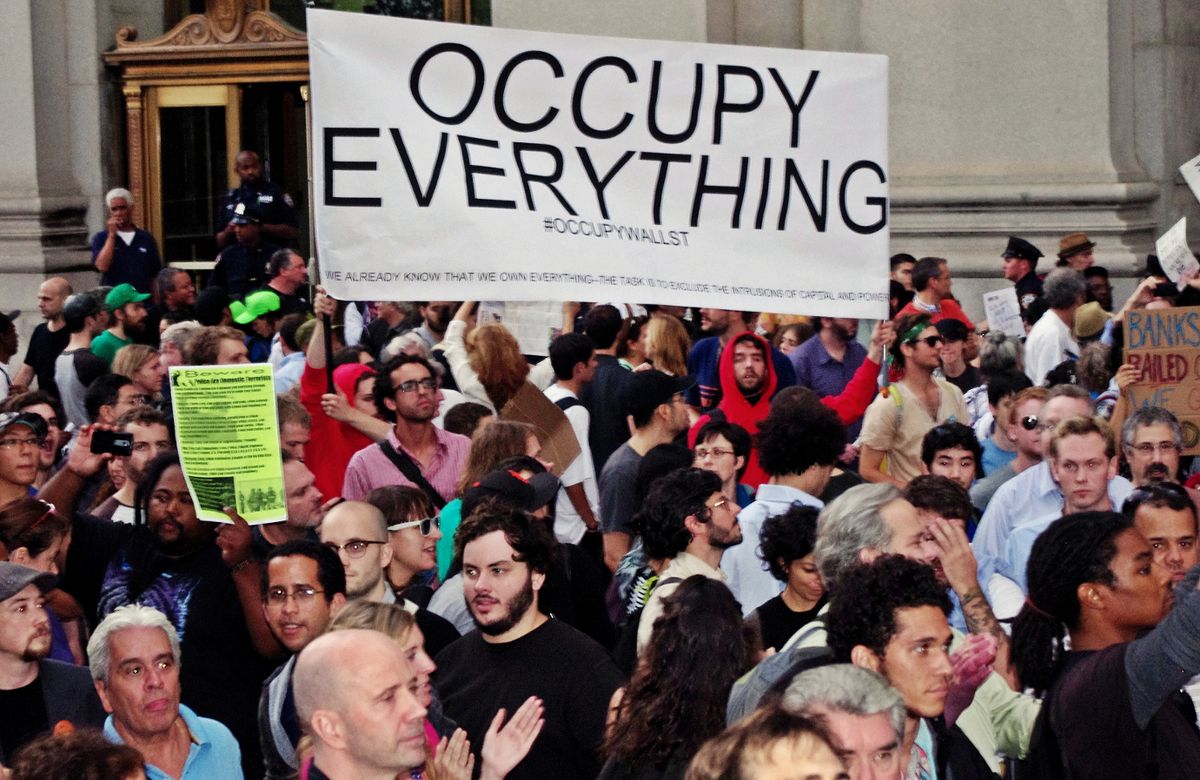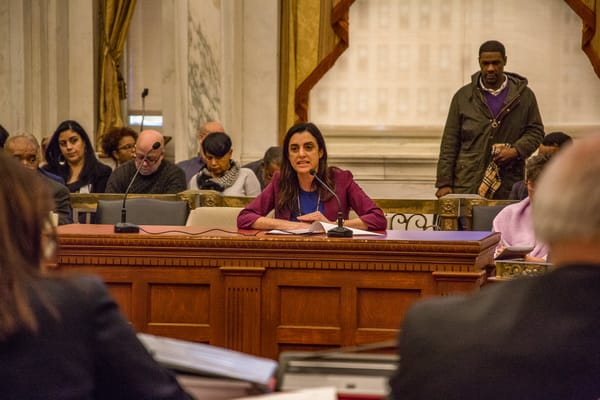Freedom Without Order

Estimates of the headcount for the Tea Party protests of 2009 vary, but no one can deny their long-term significance. While the protests themselves were only organized in the loosest sense, their impact on our politics and culture can be seen mostly in the response of formal organizations to the protests, in particular activist organizations and networks within the orbit of the Republican Party, itself one of the big institutional pillars of American democracy. Pre-existing conservative action groups sought out potential leaders and candidates for local office at Tea Party events, and their organized efforts paid off. Republicans today hold a majority of seats in 32 out of our 50 state legislatures, along with 33 governor’s seats. Even though Democratic presidents have won the popular vote in six of the seven elections since 1992, the dynamics of turnout—and, it should be said, conservative groups’ superior local organization—has left some 80 percent of the population in states with Republican-dominated governments. I do not mean to minimize the role of specific electoral mechanisms, such as the electoral college or the increasingly strict voter ID laws, which favor Republicans. But the electoral college also existed during periods of relative Democrat success, and Republicans had to get in office in the first place in order to enact the voter ID laws.
Now let us consider, for contrast, the Occupy Wall Street protests of 2011, and the larger family of national and global protests of which they were a part. They certainly set the agenda for a brief window of time. But in this case, what no one can deny is the powerlessness of these movements. The energy expressed in the various Occupy efforts was dissipated before long, and the potential leaders forgotten. There was no organized response to parallel the one that conservatives put together in the wake of the Tea Party protests, and no wave of candidates for office. The only legacy of the Occupy movement is the memory of a brief moment in which a group of angry young people screamed into the void.
In Sharing Democracy, Michaele Ferguson holds the Occupy protests up as an ideal model for a radical vision of democracy. The resistance of its participants to leadership of any kind is precisely what attracted her to it. In her analysis of the 2006 immigration protests, she explicitly criticizes the efforts of organizers to establish a cohesive method and enforce specific tactics. She looks down on those seeking to form a coalition in the pursuit of common goals. Instead, she champions protest itself as an expression of political freedom, and as a means “to sustain and promote awareness” that we all have the capability to “exercise agency together with others.” The 2006 protesters who bucked the coalition leaders and continued the controversial move of waving the flags of the nations they came from “marchers were exercising a self-authorizing democratic power that exceeds formal institutions.”
Ferguson marshals potent theoretical resources to make her case, drawn from Hannah Arendt, Ludwig Wittgenstein, Linda Zerilli, Charles Taylor, Benedict Anderson and many more. That is what I find particularly frustrating about Sharing Democracy; Ferguson weaves several interesting ideas together in an interesting way, but fails to stick the landing. In the end frameworks are only as good as how they are applied, and Ferguson took some of the best of 20th and 21st century philosophy and only managed to offer up a picture which puts radical cheerleading on equal—or even superior—footing to the goal-oriented protesters of the Civil Rights era.
Pluralism within unity
The traditional starting point of democratic theory is the demos, the “people” of “We, the People” so prominent in social contract theory, but also the publica of the res publica in civic republicanism. In short, the starting point is ideally some theoretical and pre-political conception of a unified social whole, so that when we can speak of the sovereignty of the people, we know who precisely we have in mind. In recent decades, democratic theory has been dominated by the concern that particular notions of a unified demos systematically exclude specific minorities, or papers over their mistreatment. These theorists have sought to strike a tense balance between increasing the inclusiveness and diversity of the demos framework while simultaneously maintaining the unity (or as Ferguson puts it, “commonality”) required to retain a sense of being a people. Ferguson’s argument is oriented by these theorists, whom she invites to abandon the handicap commonality imposes on their theorizing.
She argues that democratic theory:
In its insistence that the people must have something in common, or else democracy will fail, it risks ignoring or pathologizing those voices that challenge the presumption of commonality. Most important, it prioritizes the passive possession of commonality over the active exercise of political freedom.
She argues that democratic theorists look for sources of commonality in order to satisfy three key conditions: “a collective identity, an affective attachment between citizens, and the capacity to act as a singular, collective agency.” She sets out to demonstrate that commonality fails on all three counts.
For identity, she turns to the feminist debates over the nature of womanhood. Here, attempts to define that nature—however contingent on shared experience, or social construction—are always met by responses enumerating who is unjustly excluded by the definition. Meanwhile, the more radical critics do not manage to “give us the resources to understand the persistence of our belief in gender and other categories of identity,” nor to “provide the strength of will necessary to reimagine our form of life without these beliefs.”
Ferguson, following Zerilli here, argues that this isn’t because theorists have simply failed to find the correct definition. The reason is that any given sense of identity is “a part of the web of background assumptions that together form my view of the world.” As she puts it, identity is something we do rather than something we know. “We see that gender is meaningful because it comes out in complex, interrelated practices that reveal that it is a part of our worldview.” The payoff is that claims about gender and other forms of identity are different from claims about the physical universe:
Because gender is held in place not by a single proposition but by a worldview, any claims about women cannot be claims to the truth but only claims to a particular way of seeing the world. These are political claims: claims that woo assent (rather than command it), and claims that are contestable because they are partial.
This naturally builds towards her take on affective attachment, where she argues that the work that democratic theorists want commonality to do simply cannot be done at all.
Our first-person experience of affective ties of trust and solidarity, I argue, reveals that these are based in belief, not in knowledge. We can never know in advance whether stranger-citizens can be trusted, whether our sacrifices for them would be reciprocated if our roles were reversed, whether they understand our obligations to one another as we do. We misunderstand what it is to trust or to stand with our fellows when we think we do these things because of what we know about them. We care for strangers because of how we imagine ourselves to be in relationship with them. That is to say, we humans ordinarily do the work of making assumptions about one another that substitute for knowledge of how we will act in the future. We do this in personal relationships, and we do this when we imagine relationships with strangers we will likely never meet.
(…)
My point here is that affective ties are the product of human action. How we imagine the world—whether we are aware of it or not— affects whom we trust and care for. Consequently, even if we cannot simply choose our affects, they are not entirely beyond our control; they are not pure products of nature or necessity (at least not to such an extent as to render human action irrelevant). And if they are the product of human action, then we can act intentionally so as to try to shape our relationships in better or worse ways—even though we cannot guarantee an outcome.
When democratic theorists fixate on finding sources of commonality so that it can in turn produce affective attachment, they ignore their responsibility for creating affective attachment—a responsibility they share with all of us, in Ferguson’s radically democratic vision of how social reality is imagined and maintained. Trusting one another is always a matter of faith, of taking that leap in the dark and hoping we aren’t the only one to do so.
Ferguson centers her analysis on individual experience and the notion of intersubjective “testing.” We can only confirm our perceptions of the world when we perceive “other beings who seem to sense it, too.” We seek to confirm the validity of our “thoughts and judgments by making them communicable to others.” In seeking to confirm these judgments, especially when they are specifically political or aesthetic judgments rather than judgments about the world of physical objects, we participate in the process of “world-building” and sense-making for all of us. Our constraints are social ones, not physical: “We are constrained by the physical properties of the world in which we live; we are limited in our capacity to share meaning by how other people respond.”
This focus on individuality undermines many of the effects theorists expect a sense of unity to have:
Disagreement, disappointment, and disaffection are to be expected in a world that we inhabit together with plural others. We share the world with people who see matters differently, and we should expect them to surprise, confound, and annoy us from time to time. This may be especially the case when the stakes are high, as with a presidential election, a major policy proposal, congressional redistricting, redressing group discrimination, and so on.
Ferguson’s ambition is not to minimize “disagreement, disappointment, and disaffection,” but to imagine a version of collective agency “that warmly embraces disagreement as one of its many manifestations, instead of nervously viewing it as a sign of failure.” She names her vision of collective agency democratic interagency, “the dialogic agency that emerges in the interactions between persons engaged in making claims about how we should imagine our shared world, wherever these interactions should occur.”
She thus has her answer, a commonality-free vision of collective agency:
We form a collective agency, on this view, when we interact with one another. Disagreeing, arguing, and losing are all forms of interaction, and so they contribute to, rather than undermine, collective agency. Indeed, agreement is neither a necessary condition for nor a necessary outcome of our interacting together. Collective agency falters not when we lack agreement about collective intentions and purposes but when our interlocutors disengage, do not respond, fail to hear us, or simply do not take us seriously. Consequently, the aim of a democratic politics emerging from this concept of interagency is to facilitate and perpetuate interaction between people, and to proliferate the opportunities for interaction.
And this is precisely where her theoretical edifice goes off the rails, beyond the errors she makes in application. To call any interaction among individuals “collective agency” is an abuse of language, even if that interaction is “dialogic”. One may argue that there is no such thing as collective agency, as plenty of methodological individualists do in the social sciences and elsewhere. Ferguson effectively does this but seems to think she has not.
Once this last step is established, however, it is not a great leap to holding Occupy Wall Street up as the model of democracy in action. If interaction per se is democracy, so long as it is available to any individual, then what seems to goal-oriented partisans like impotent venting becomes a venue for mutual testing and meaning-making. Ferguson in fact makes it very clear she disdains goal-oriented protesting, and even the very idea of political coalitions that come together purely to pursue shared goals. Instead, it is the expression of political freedom that has value in itself.
When we engage in politics primarily to achieve particular outcomes, we instrumentalize political action: we see our activity as valuable only insofar as it produces the results we desire. This outcome orientation to politics can undermine the motivation to act. If we achieve our goals, then it appears there is no more reason to engage in political activity. If we do not achieve our goals, then we may become demoralized and unmotivated to continue the struggle. An attachment to outcomes in politics is an unstable source of motivation because we cannot guarantee what the results of our political activity will be in a world of plural subjects. My wager is that, if we place the stress instead on the activity of political freedom itself, and acknowledge the uncertainty that we will achieve the specific outcomes we desire, we will be better able to maintain the enthusiasm and commitment to political activity that we need to weather the risks of acting in a world we share with others.
I would take the other side of that bet. Stressing “the activity of political freedom itself” is where we move beyond Occupy Wall Street and into the realm of radical cheerleading; protest as self-expression for the privileged. For the 19th century abolitionists, the suffragettes, the Civil Rights protesters, and the current Black Lives Matters protestors, there were and are matters of grave significance at stake. When the primary concern is the end of chattel slavery, or the enfranchisement of women and minorities, or life and death, the long term stability of the coalitions you build is a secondary concern at best. Ferguson worries that coalition politics risks being “conservative, unimaginative, and complicit in the status quo,” but what could be more complicit in the status quo than the expression of political freedom for its own sake, without doing your due diligence in trying to actually influence some outcome?
Institutions and majoritarian partisanship
But there are matters of significance at stake in Ferguson’s analysis, too. And this is precisely what is frustrating about the book. Until we arrive at the matter of collective agency, I find much of value in Ferguson’s analysis and framework. Theories and narratives that stress unity and being a people tend to cast suspicion on internal division of any kind. It becomes all too easy to conflate dissent with disloyalty or, in the limit, treason. And the pieces that Ferguson attempts to put together are excellent starting points for building an alternative: Anderson’s imagined communities, Wittgenstein’s language-games, and Arendt’s existential analysis of individual subjective experience have never been put together in quite the way that Ferguson attempts to. A successful synthesis could have offered a powerful defense of individuality and pluralism within the framework of institutional democracy.
Unfortunately, she is so focused on her goal of eliminating the need for commonality that she breezes over some rather crucial aspects of this framework. To wit: our notion of identity is generated by “a web of background assumptions” that come out in “complex, interrelated practices.” Even if these practices are “overlapping, inconsistent, and even contradictory,” they are still shared. I would go so far as to say that these practices, and these background assumptions, are something that people have in common.
Wittgenstein, whose work underlies much of Ferguson’s framework either through direct influence or by influencing people like Zerilli, argued against treating words as if they had some essential definition. He instead suggested they were given meaning as moves within what he called “language-games.” The reason he chose games as a metaphor is because of the versatility of the word. Chess is a game, but so is soccer, and so is Pictionary. Ferguson seems to have concluded, incorrectly, that this means there is no commonality in what constitutes a game. Instead, Wittgenstein says they have a family resemblance, which is precisely what Ferguson’s “overlapping, inconsistent, and even contradictory” practices have. This family resemblance, in which there is no one commonality that encompasses the whole family, is nevertheless a resemblance.
What is more, the practices almost universally occur in an institutional context. Institutions are self-consciously left out of Ferguson’s analysis. As a result, the shared practices that she invokes appear as something of a black box. When she does provide a concrete example, it is a highly institutional one. The example comes from Benedict Anderson’s Imagined Communities:
Anderson’s answer is that the identity of ‘Indochine’ was reflected in real experiences, or in the language I have been using here, social practices. In particular, the colonial administration set up an educational system in the early twentieth century that gave Indochina reality for those who took part in it. This system aimed to produce a native elite capable of speaking and reading French to serve in particular in the colonial bureaucracy. However, because there were a limited number of upper-level schools and only one university, the students who advanced in this school system converged in the same few places. Here, they had classmates who were Vietnamese, Laotian, and Khmer; by coming together, they experienced Indochina as real. These face-to-face interactions with other Indochinese in turn facilitated the imagining of a community beyond the schools.
Here we encounter colonial administration, a governance institution backed by the French military, setting up educational institutions, which fostered a specific shared identity. Moreover, once the situation changed and the schools were regionalized, the identity fell apart. This example is a peculiar one for Ferguson to have picked, because it seems to completely subvert her purpose. Here we have an education system that created a commonality, and thus an identity. Once the commonality was removed, the identity disappeared. Ferguson points out that having just one shared practice like this leaves an identity more fragile than if it had many, more complexly intertangled ones; it still demonstrates that common practices are at the root of shared identity.
Intersubjective relations are a useful starting place, but relationality per se is not very informative. There are many types of relations, with different implications in different contexts. One important relation that is absent from Ferguson’s analysis is membership. This relation is not between individuals, but between an individual and an entity—an “imagined” entity, in Anderson’s sense, though this is misleading. When the conditions are right, such entities are no more or less imagined than money. Imagined social entities in which individuals are members are precisely the collective agencies that Ferguson mis-defines.
The democratic theorists that Ferguson criticizes are concerned about the fate of the institutions of democracy. They hoped that theory and reasoning could help them find a way to expand effective membership and participation in these institutions, but also how they might be preserved. So while it appears that Ferguson is addressing them, in fact she answers a question they do not ask, and never addresses the one that they do. As with the phrase “collective agency”, we can call outcome-indifferent (or perhaps more fairly, outcome-secondary) public interaction “democracy,” but it doesn’t tell us much about the system of electing legislators and executives and judges, or voting in referendums.
Ferguson’s framework needs to bring concrete institutions and specific practices in to keep it from floating into the clouds. I think the work of Nancy Rosenblum on partisanship and voluntary association could take Ferguson’s framework the extra distance it needs to go. Studying varieties of membership is an important part of Rosenblum’s work, and the conclusions she draws could offer resources that Ferguson desperately needs.
Rather than attempting to eliminate commonality entirely, imagine a pluralism with competing and incompatible narratives of commonality, each pushed by groups seeking to include as many people as they can unless it involves undermining that narrative. In her defense of parties and partisanship, Rosenblum offers just such a vision, in which parties which aspire to be majorities offer each a “comprehensive public story” in order to draw in as much of “the great body of the people” as they can. Here is a framework that can be fleshed out with resources that Ferguson provides: each major party offers an imagining of the demos, and even when they are in the minority they claim to speak for the true character of the nation (“real Americans”). This is not so different from how Ferguson describes the Tahrir Square protestors:
On the morning of January 25, the protesters took action without knowing how things would turn out. They made claims in the name of Egypt, without knowing whether other Egyptians, and enough Egyptians, would agree with them.
In our posited synthesis of Rosenblum and Ferguson, partisans no less than protestors can make a claim to the name of Egypt, or America, or Christianity, or any shared identity. Ferguson is greatly concerned to emphasize individual experience and not to subvert it to a vision of unity which will inevitably leave some excluded and others misrepresented. Rosenblum accomplishes this aim by focusing on concrete, organized groups.
The first step is to transfer individuality from persons to the group. ‘If we value autonomy,’ Walzer writes, ‘we will want individual men and women to have their own lives,’ and the same argument holds for ‘the people/nation.’ This step is facilitated by a disembodied view of groups. Concrete associations reveal a group’s internal diversity. Through their activities and alliances, associations indicate greater and lesser degrees of affinity and integration with ‘outside’ groups, giving the lie to the grand contrastive strategy of posing a unique cultural or racial identity against a homogeneous wider society.
Democratic theory’s greatest sin isn’t its intense focus on commonality. Its biggest shortcoming is excessive abstraction. As Rosenblum rightly notes, observing the workings of real groups, rather than groupings imposed by a theorist through some abstract schema, and we cannot fail to notice their internal diversity.
More importantly, who is organized, and how they are organized, and in what institutional setting, are questions that give a sense, however imperfect, of the social possibilities. Ferguson opens her book with Tahrir Square in order to inspire, but it should serve as a caution. Unlike the Occupy protestors, the Arab Spring protests did accomplish things in their nations. In Egypt, unified only by the status quo, the protestors successfully ended Mubarak’s 30-year-reign. But often it is the most robustly organized group who manages to step into the institutional voids created by such situations. In Russia a hundred years ago, it was first the socialist networks in general, and then the Bolsheviks in particular. In Egypt, they did not even manage to create an institutional void—the institutions behind Mubarak remain intact, and thus the most robustly organized group remains the military. The short-lived triumph of Tahrir Square has ended not in hope, but in blood and terror.
If we as liberals do not wish to cede the field to authoritarians, totalitarians, and reckless populists, then we need to take organization, institutions, and coalition-building seriously. Less dramatically, we will need to take those things seriously if we ever want to take back any significant portion of the 32 state governments currently dominated by Republicans. Let us treat the way Occupy was handled as a mistake to be learned from, and move on.
Featured image is Day 14 Occupy Wall Street September 30 2011, by David Shankbone




